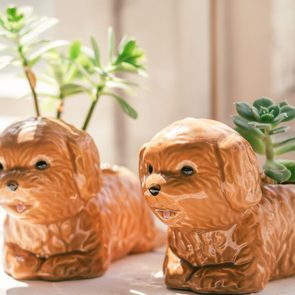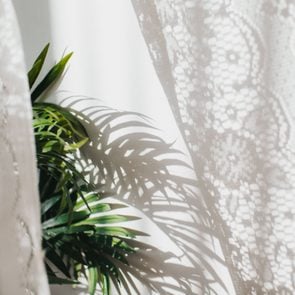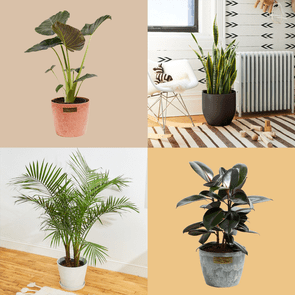How to Get Rid of Aphids
Updated: May 24, 2023

Sluggish growth? Yellowed, crinkled or sticky leaves? Aphids may be the culprit.
Whether you’re a new plant parent trying your hand at low-maintenance indoor plants or an experienced gardener who loves to buy plants online, you might have come across a colony of tiny pear-shaped bugs hanging out on your indoor plants. Beware: These are sap-feeding insects called aphids. They’re harmless to humans and pets but will do serious damage to your favorite air-purifying plants.
If you currently have these houseplant pests lurking around your favorite low-light indoor plants, hanging plants or bathroom plants, don’t panic. Once you know a few key facts—where do aphids come from, and how to get rid of aphids—you’ll find that when they’re treated promptly and properly, it can be easy and affordable to rid houseplants of aphids. Read on for everything you need to know to banish these minuscule sap-suckers once and for all. And if you think you may be dealing with another type of pest, we’ve also put together handy how-to’s to help you get rid of mealy bugs or get rid of spiders.
Get Reader’s Digest’s Read Up newsletter for humor, cleaning, travel, tech and fun facts all week long.
What are aphids?
Aphids, also known as plant lice, are small insects that grow up to an eighth of an inch. If you have aphids on houseplants, they’re most likely to be light green. However, they can also be yellow, orange, red, beige, pink or black, and they’re usually found underneath leaves or in the center of new shoots.
What are aphids doing on your plants? The pesky bugs are sap suckers, meaning they feed on young shoots and leaves by piercing the plant with their sharp mouthpieces. As they feast, aphids leave behind a sticky substance called “honeydew.” This waste product (yep, honeydew is a polite term for aphid poop) can also foster the growth of a fungus called sooty mold, which further damages your plants by blocking light from the leaves. Because they can be fairly common, knowing how to get rid of aphids is essential knowledge for any plant parent.
What causes aphids?
Aphids are drawn to new growth like young shoots and leaves. If you have flowering plants, aphids will head straight for unopened flower buds. Wondering exactly how they got onto your favorite spider plant or fiddle leaf fig? The answer, believe it or not, could be you. You may have inadvertently brought in an already infested plant. Or, if you’ve spent any time outside in your garden, one of these little buggers could have attached itself to your clothing. And since female aphids can give birth to anywhere from three to six babies a day without mating, you could go from one or two bugs to a full-blown infestation in no time.
How to get rid of aphids
Since aphids multiply rapidly, you’ll want to treat them as soon as possible. Fortunately, there are a few simple ways to get rid of aphids for good.
Water
If you find aphids on one of your smaller houseplants, then you can either take it outside or to your kitchen sink. Use your garden hose or faucet to spray the aphids off your plant. Once you’ve gotten all the aphids off, be sure to wash away any honeydew they might have left behind. If the aphids have already caused damage, some extra TLC may be required to revive your dying plant.
Sugar, water, vinegar and banana peel
If blasting away aphids with water doesn’t feel like enough, then a homemade aphid trap may be the way to go. Mix one cup each of water, sugar and vinegar in an empty jug or container. Add a few pieces of chopped banana peel, and place the mixture in or near your infested plant for up to a week to attract and drown the aphids. Replace the mixture each week until the aphids are gone.
Insecticidal soap
Insecticidal soaps contain fatty acid salts that damage the cell membranes of soft-bodied insects, resulting in a quick death without harming your plants. That being said, you’ll have to spray your plants frequently until the bugs are gone. You can purchase a ready-to-use insecticidal soap or make your own by diluting a teaspoon of dish soap in a quart of water. Spray your plant every two to three days, making sure to get the undersides of the leaves.
Neem oil
Neem oil is an organic pesticide made from neem tree seeds. Like insecticidal soap, this spray will kill aphids and other pests on contact but is perfectly safe for plants. This ready-to-use neem oil spray is safe and easy to use and will kill eggs, larvae and adult aphids. Just shake the bottle, spray your plant until there’s run-off and repeat once a week until the aphids are gone. As an added bonus, this oil also acts as a fungicide and will help control powdery mildew on plants.
Chemical insecticides
If you’re dealing with a severe infestation, then you may have to use a chemical insecticide. Look for a Pyrethrin-based insecticide spray. Pyrethrin is a plant-derived insecticide that has a low toxicity to humans and pets. This Pyrethrin Garden Insect Spray kills aphids by targeting their nervous systems. You’ll have to mix this insecticide with water in a spray bottle, so be sure to carefully follow the directions on the label. This one is a sure-fire way to get rid of aphids, but not everybody will want to use chemical insecticides in their home.
Sticky traps
You can always put a couple of sticky traps, like these Garsum Yellow Sticky Traps, in your plants to catch any aphids that might have taken up residence in your home. Though aphids tend to walk rather than fly, just one step onto these bright yellow traps and they won’t be able to escape. Plus, these traps are a great way to get rid of fungus gnats if you have those lurking around as well.
How to prevent aphids
To prevent aphids on houseplants, inspect your plants regularly so you can stop any infestations before they truly begin. You should also isolate any new houseplants or plants you’ve brought in from outside for two to three weeks. That way, if a plant is already infested with aphids, you can treat it using the methods listed above without worrying about the aphids moving onto another plant. Knowing how to get rid of aphids may just save your plant (and your sanity)!
Sources:
- Missouri Botanical Garden: “Aphids – indoors“
- New York Botanical Garden: “What is attacking my hibiscus flower buds?“























